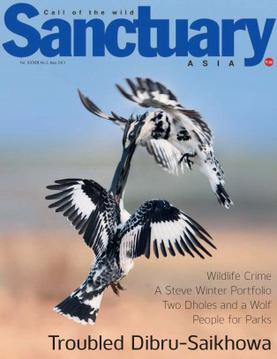Related Research Articles
Project Tiger is a tiger conservation programme launched on April 1,1973 by the Government of India during Prime Minister Indira Gandhi's tenure. The project aims at ensuring a viable population of the Bengal tiger in its natural habitats, protecting it from extinction, and preserving areas of biological importance as a natural heritage that represent the diversity of ecosystems across the tiger's range in the country. The project's task force visualised these tiger reserves as breeding nuclei, from which surplus animals would migrate to adjacent forests. Funds and commitment were mustered to support the intensive program of habitat protection and rehabilitation under the project.

The Bengal tiger is a population of the Panthera tigris tigris subspecies and the nominate tiger subspecies. It ranks among the biggest wild cats alive today. It is considered to belong to the world's charismatic megafauna.

Kenneth Douglas Stewart Anderson was an Indian writer and hunter who wrote books about his adventures in the jungles of South India.
Guy Mountfort was an English advertising executive, amateur ornithologist and conservationist. He is known for writing the pioneering A Field Guide to the Birds of Britain and Europe, published in 1954.
Frederick Walter Champion was a British forester, who worked in British India and East Africa. In the UK and India he became famous in the 1920s as one of the first wildlife photographers and conservationists.

Dame Virginia Anne McKenna is a British stage and screen actress, author, animal rights activist, and wildlife campaigner. She is best known for the films A Town Like Alice (1956), Carve Her Name with Pride (1958), Born Free (1966), and Ring of Bright Water (1969), as well as her work with the Born Free Foundation.
Edward Pritchard Gee (1904–1968) was a Cambridge educated, Anglo-Indian tea-planter and an amateur naturalist in Assam, India. He is credited with the 1953 discovery of Gee's golden langur. He is notable as an early influential wildlife conservationist, especially for his 1959 and 1963 surveys and recommendations resulting in the creation of Chitwan National Park, the first of nine national parks in Nepal.

The Indian leopard is a leopard subspecies widely distributed on the Indian subcontinent. The species Panthera pardus is listed as Vulnerable on the IUCN Red List because populations have declined following habitat loss and fragmentation, poaching for the illegal trade of skins and body parts, and persecution due to conflict situations. The Indian leopard is one of the big cats occurring on the Indian subcontinent, along with the Asiatic lion, Bengal tiger, snow leopard and clouded leopard. In 2014, a national census of leopards around tiger habitats was carried out in India except the northeast. 7,910 individuals were estimated in surveyed areas and a national total of 12,000–14,000 speculated.

Sanctuary Asia is an Indian nature and wildlife conservation magazine founded in 1981 by Bittu Sahgal, its current editor. The magazine expanded in 2015 to become established as a non-profit foundation.
India is home to a large variety of wildlife. It is a biodiversity hotspot with various ecosystems ranging from the Himalayas in the north to the evergreen rain forests in the south, the sands of the west to the marshy mangroves of the east. India lies within the Indomalayan realm and is the home to about 7.6% of mammal, 14.7% of amphibian, 6% of bird, 6.2% of reptilian, and 6.2% of flowering plant species. India's forests contain about 500 species of mammals and more than 1300 bird species.

Pench Tiger Reserve or Pench National Park is one of the premier tiger reserves of India and the first one to straddle across two states - Madhya Pradesh and Maharashtra. The reference to Pench is mostly to the tiger reserve in Madhya Pradesh.
Anthony Raymond Fitzjohn, OBE was a British conservationist who worked extensively with George Adamson at Kora in Africa. In recognition of his service to wildlife conservation, Fitzjohn was appointed an Officer of the Order of the British Empire in 2006.

The National Tiger Conservation Authority (NTCA) was established in December 2005, following a recommendation of the Tiger Task Force, The Prime Minister of India established it to reorganise the management of Project Tiger and India's many Tiger Reserves in India.

The Wildlife Protection Society of India (WPSI) was founded in 1994 by Belinda Wright, its Executive Director, who was an award-winning wildlife photographer and filmmaker till she took up the cause of conservation. From its inception, WPSI's main aim has been to bring a new focus to the daunting task of tackling India's growing wildlife crisis. It does this by providing support and information to government authorities to combat poaching and the escalating illegal wildlife trade - particularly in wild tigers. It has now broadened its focus to deal with human-animal conflicts and provide support for research projects.

Conservation in India can be traced to the time of Ashoka, tracing to the Ashoka Pillar Edicts as one of the earliest conservation efforts in the world. Conservation generally refers to the act of carefully and efficiently using natural resources. Conservation efforts begun in India before 5 AD, as efforts are made to have a forest administration. The Ministry of Environment, Forest and Climate Change is the ministry responsible for implementation of environmental and forestry program in India, which include the management of national parks, conservation of flora and fauna of India, and pollution controls.

Nilgiri Wildlife and Environmental Association (NWEA) is a non-governmental organization registered in Tamil Nadu, India. Their objective is to conserve the wildlife, habitat and natural resources of the Nilgiri Hills.
Bahar Dutt is an Indian television journalist and environmental editor and columnist for CNN-IBN.
Saroj Raj Choudhury was an Indian environmentalist, wildlife conservationist, writer and the first Forest Conservator under the Government of Odisha. He was also the founder director of the Simlipal National Park, in the Mayurbhanj district in the Indian state of Odisha. Choudhury was known for the pugmark technique he employed for tiger census and for his comradeship with Khairi, a domesticated tigress. His experiences with the animal has been documented in a book, Khairi: The Beloved Tigress, written by him and published in 1977. The Government of India awarded him the fourth highest Indian civilian honour of Padma Shri in 1983.
Latika Nath is an Indian author, photographer and wildlife conservationist. Featuring her work, in 2001, she was awarded the title of 'The Tiger Princess' by National Geographic which featured her in a one-hour documentary film. She has worked since 1990 for the conservation of tigers in India. In May 2020, she was bestowed with the honorary title of "Her Daringness" by Mr Nitin Gupta in a cover story based on Latika's life and work, and featuring her work on wildlife conservation.

Yadvendradev Vikramsinh Jhala is an Indian scientist and conservationist. He recently ended his tenure as the Dean at the Wildlife Institute of India in Dehradun.
References
- ↑ "Belinda Wright, One-woman Tiger Team". Sanctuary Asia. April 2005. Archived from the original on 17 May 2008. Retrieved 30 March 2009.
- 1 2 "The Wright Family". Kipling Camp. 2008. Archived from the original on 11 April 2009. Retrieved 30 March 2009.
- 1 2 Bhardwaj, Ashutosh (25 January 2007). "Interview : Belinda Wright, Passion of the Tiger". Delhi: DevelopedNation.org. Archived from the original on 16 March 2008. Retrieved 30 March 2009.